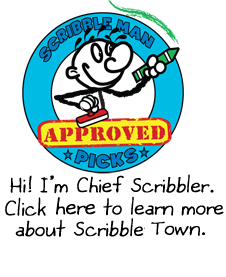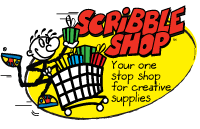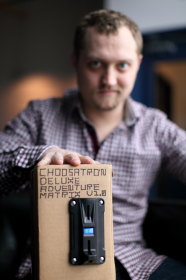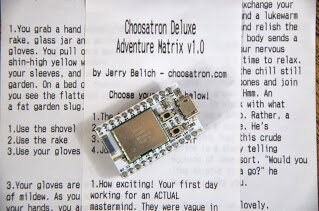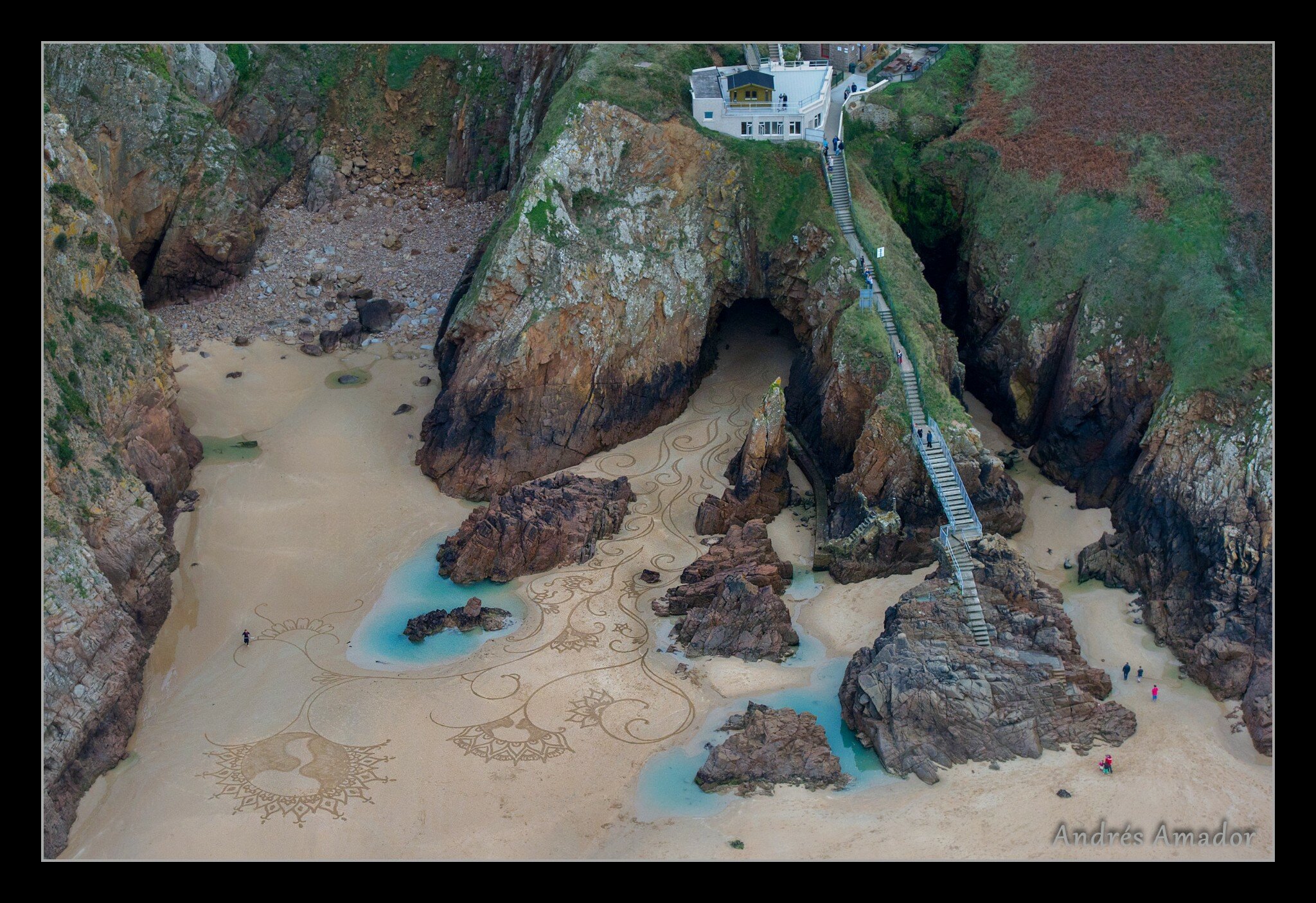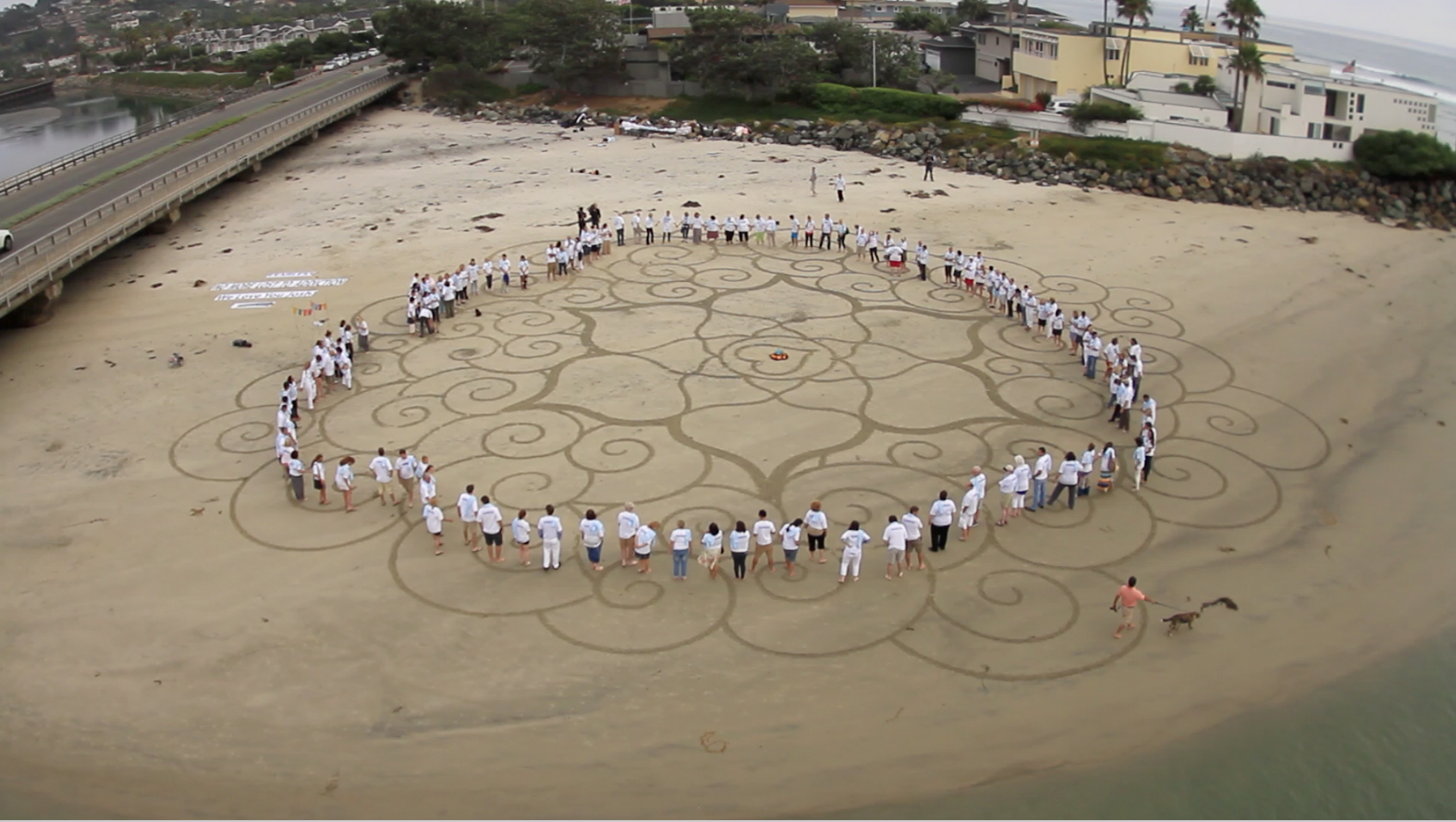
Day 106 by Susa Talan
Scribble Town (ST): The perfect combination of image and words made by Susa Talan brings the meaning of the highlighted quotes to new visions. Susa’s artwork speak to me. The voice of the author from the quote she bases her artwork on is heard. And I think I’m not the only one! She is often on the move so I wonder, where are you, Susa, and what are you up to these days?
Susa Talan (Susa): At the moment, I’m spending time on a beautiful lake in Southern Maine. My partner and I moved out of our tiny home in rural Massachusetts in May and have spent the spring and summer traveling and visiting with friends and family before deciding where to make our next home. We have lived and traveled in many places over the last 6 years–both in the US and abroad (England, China, Burma, New Zealand, Australia). We like to travel. I actually find it inspiring to draw when we are on the move. That said, I am in the middle of a 365 day illustration project, so I am drawing every day and also starting a small stationery line. It’s definitely more challenging to do all this on the move! So as September looms, we’re both feeling ready to make a home again.

Day 58 by Susa Talan
ST: The movement of travel and seeing everything new and unexpectedly is very exciting! Drawing on the road is a great way to capture it all. When did you start illustrating? Was there somebody that encouraged you? If there is a story of your path to finding this medium that fits you so well, please share.
Susa: One of my strongest early memories of illustration is from middle school. I did a project on Walt Disney, the artist, and I made a poster full of Disney characters that I hand-drew myself. I really appreciated how precise and detailed those drawings were and I learned from his example. I loved that poster and kept it on the wall of my bedroom. I still have a vivid memory of what it looked like!
My earliest experiences with art, however, come from my time in elementary school. I attended The Common School, in Amherst, Massachusetts which is deeply rooted in creative learning through art, theatre, music, the outdoors. For nine years I was given the choice to draw as a morning activity, surrounded by art materials and free time to explore them. Because of this, my relationship to learning and to making things–anything, really–is naturally integrated with my impulse to make art. I also have a creative older sister who is a musician and an artist. So both at school and at home there were really immediate artistic influences.

Day 96 by Susa Talan
For many reasons I moved away from art and poetry in high school and it wasn’t until my senior year in college, that I ended up in a poetry class, by some small miracle, and it really changed the course of my life. I dropped my senior thesis in psychology and I started writing poems again. It wasn’t long before I was painting and immersing myself in art. Over the next 7 years, I went to museums and galleries and poetry readings. I read artist biographies and explored painting. I reconnected with my love of both writing and art–and even began, for the first time, to combine them by putting text and language into my paintings. This has always been a very deep wish. To bring text and words into my art. Among many, one person who influenced me during this time is Janeen Koconis, the artist behind the very successful cards, KOCONY. I loved her work. I still love her work. I never met her, but I bought her cards over and over again. She was the first person who I saw putting text together with art in such a way that really moved and inspired me.
Though I desperately wanted to go to art school, I was afraid that I couldn’t make a career of art. I was convinced that it was impractical and so I made a very practical decision to become a teacher and go to graduate school in education. I loved children and teaching came naturally to me, so there were many good reasons to have made this choice. And this became my focus for many years—nearly 15 in all. I worked in schools as a teacher and then a tutor and later I consulted with teachers and parents. I still care deeply about the development of children and their experience of learning. And even today, I run occasional parenting workshops for parents.

Day 108 by Susa Talan
Over all these years, my deep love of art and poetry stayed alive in lots of ways. I made cards for friends. I made small paintings. I wrote in a journal and I wrote poems. I eventually even went to art school for one year, in my early thirties. Unfortunately, it was a year of artistic struggle that felt a lot like artistic failure. I didn’t know how to make the kind of art I truly wanted to make. I didn’t know how to trust my artistic voice. At the end of the year, I left feeling very discouraged. I abandoned art-making altogether.
In 2006, a family crisis put everything in perspective and I left my home and life in Boston to join a Buddhist meditation center. For the next 3 years, I didn’t make any art and immersed myself in meditation and contemplative practice. Eventually, I left the center and life took me back to teaching and education and travel.
One day, without plan or preamble, I picked up a single micron pen and an old sketchbook. I started drawing. I drew and drew and drew. So many wonderful things began to happen! I drew butterflies and trees. I drew people and buildings and birds and dogs and patterns. This went on for a year and then another year. Eventually, words starting coming, too. Words of my own and quotes from people I admired and read. Poets, writers, scientists, biologists, artists. Anyone who had inspired me. Eventually, one thing led to another. Two different singer-songwriter friends asked me to illustrate their album covers. I bought the Adobe Creative Suite and learned Photoshop and Illustrator. In December, 2012, on my 39th birthday, I committed to giving myself a year of daily gratitude, a year of making illustrations every day, a year of creative discipline.

Day 137 by Susa Talan
And the rest, as they say, is history. I am finally living the dream of making art full-time. I’m selling my cards in stores around the US, as well as working on a 2014 calendar and a 365 Days of Gratitude book.
ST: I love the way you told your story! Your earnestness for art making is very much felt in the vibrant way you use words. And now we have a calendar full of your artwork to look forward to!
When you illustrate what is your creative process like? Does your image come after your quote or vice versa? How do you come across these amazing and meaningful quotes?
Susa: My creative process is pretty much the same each time I work, with some variation depending on the project. Most often, I start with a quote or words. Choosing them, selecting them, is it’s own process. There are so many writers whose words have kept me company over the years that finding authors is not the challenge. The hard part is finding quotes that pass something like a sparkle test. Which basically means it moves me, pretty instantly, in some deep way. Like a little whir or spark. A hit of recognition. Because there are a million wonderful quotes out there, but not all of them produce that sparkle in me—something that feels universally meaningful. It’s hard to explain. But I know right away when I come across a quote if it will work.

Day 213 by Susa Talan
Once I have some quotes, I look for one that produces a similarly quick visual idea. Since I’m working with a daily deadline for the gratitude project, I don’t have much time to re-work an idea. If a quote with sparkle gives me an image, I run with it and start drawing. If it doesn’t produce an image right away, I put it on hold and keep looking.
ST: Time and silence are sometimes the best way for ideas to rise to the top. Please tell us a bit about your 365 Days of Gratitude project. What day are you on?
Susa: The 365 Days of Gratitude project was conceived as both an exercise and a gift. On the creative side, I was looking for a long-term project that would get me working everyday under a deadline. Last fall, I discovered the work of artist and illustrator Lisa Congdon who was only a few months away from finishing a 365 Days of Hand-Lettering project. I was so inspired by her work and her commitment to this year-long project. I knew I wanted to do something similar. On a personal level, I wanted to offer myself a year of gratitude for my 40th birthday year. That seemed like a meaningful way to enter my fourth decade of life. So I started the project the day after my 39th birthday. It will finish at the end of December 2013.
Some days I have to remind myself of what I’m grateful for. That sounds kind of funny given that I’m engaged in a daily gratitude project. But it really feels like part of the path of being human. Don’t we all need reminders to be kind, to feel something directly and not just think about it? So that’s a big part of this project for me, personally. I try and remind myself throughout each day what I’m grateful for. And then creatively, it’s just been amazing to evolve artistically this year and be working so much each day. Today is Day 218!

Day 80 by Susa Talan
ST: It must be nice to wake up and be totally aware of which day it is and how it places in context to the yearly calendar. Sometimes I don’t even know what day it is!
What is your process for getting your work out of your head–do you sketch with pencil, paint, computer graphics, etc?
Susa: I don’t sketch or plan out my drawings much beforehand. Once an initial idea comes into my mind, I run with it and the drawing evolves while I work. Most of my drawings come out in one take. I don’t tend to re-work or redo a drawing.
Once the image is done, I’ll scan it into the computer. If any minor edits are needed, that happens in Photoshop. Once the lines of the image are set, I’ll bring it into Illustrator and colorize. In terms of my tools, I work with about 5 different sizes of black micron pens.
ST: When you are creating these days what kind of music are you listening to? What is your studio environment like?
Susa: I don’t tend to listen to music when I draw. I enjoy silence and find it pretty necessary for the kind of concentration I use during the drawing phase. It doesn’t need to be pin-drop silent. I just like a quiet space, and the natural sounds of life happening around me. Once I enter the computer phase, I do listen to music and often to podcasts. My current favorite is “On Being” with Krista Tippett. Even though I don’t often listen to music while I’m working, music is a big part of my creative life. I play guitar and it provides a really different, but complimentary, creative outlet. So lots of inspiration there. Recently, I’ve been going back to Paul Simon. I came across his album “Graceland” and forgot how much I love it. He’s such an innovator.
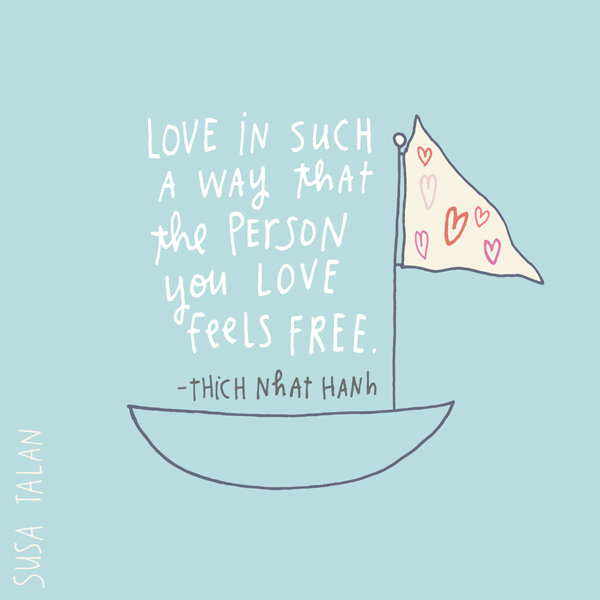
Day 199 by Susa Talan
ST: Many childhood family road trips were spent belting out Paul Simon. I should bring him out again too! Out of all of the quotes and sayings you have depicted, which one holds a very close spot to heart at the moment? For me, Thich Nhat Hanh’s quote for Day 199 really spoke to me and your picture made it all the more clear, tangible and understandable.
Susa: Each gratitude page holds a different connection and relationship for me. And yet, over the year, different pages do, inevitably, feel more or less impactful. Right now, Day 207, the Ernest Hemingway quote, “The best way to find out if you can trust somebody is to trust them” has been a strong one for me. I was really pleased with how the illustration came out and felt it embodied what I had hoped to with the quote—which is so potent, so true, in my experience. The practice that the quote implies, moving towards trust when you feel untrusting, is a deep one.
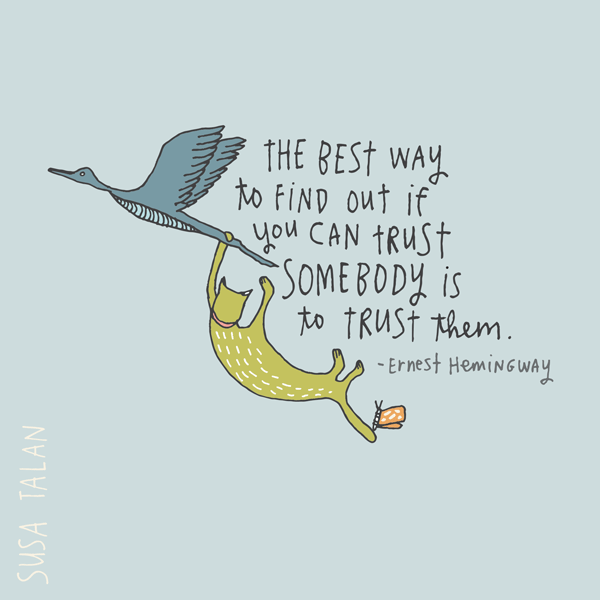
Day 207 by Susa Talan
ST: Susa, you have touched us and opened our eyes to many great people who value life and being. Thank you for that! To see more great artwork by Susa, please visit her website, http://susatalan.com/.
Special treat today is ‘Drawing with Susa Talan’ on the Scribble Shop! To do the art activity with Susa, you can click here. Let’s enjoy the moment, but I have to say that I’m getting giddy for the Susa’s 2014 calendar and 365 Days of Gratitude book. Check back for more details!

Day 136 by Susa Talan

